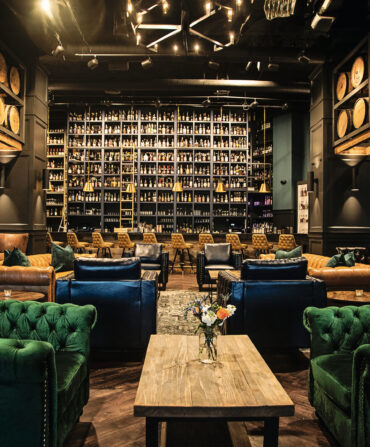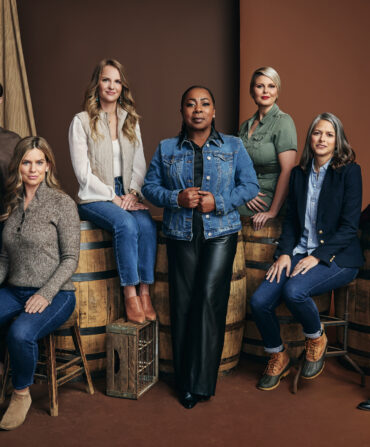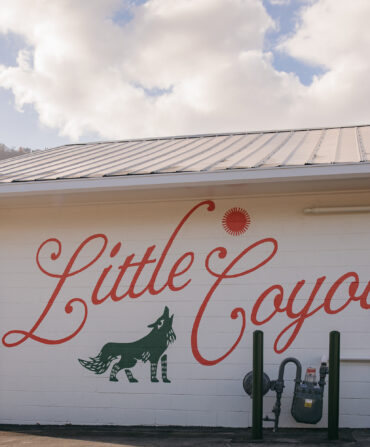Food & Drink
Memphis in May: Pork-a-Palooza
A team of pit masters goes to Memphis in May to answer a burning question: Can great barbecue still win?
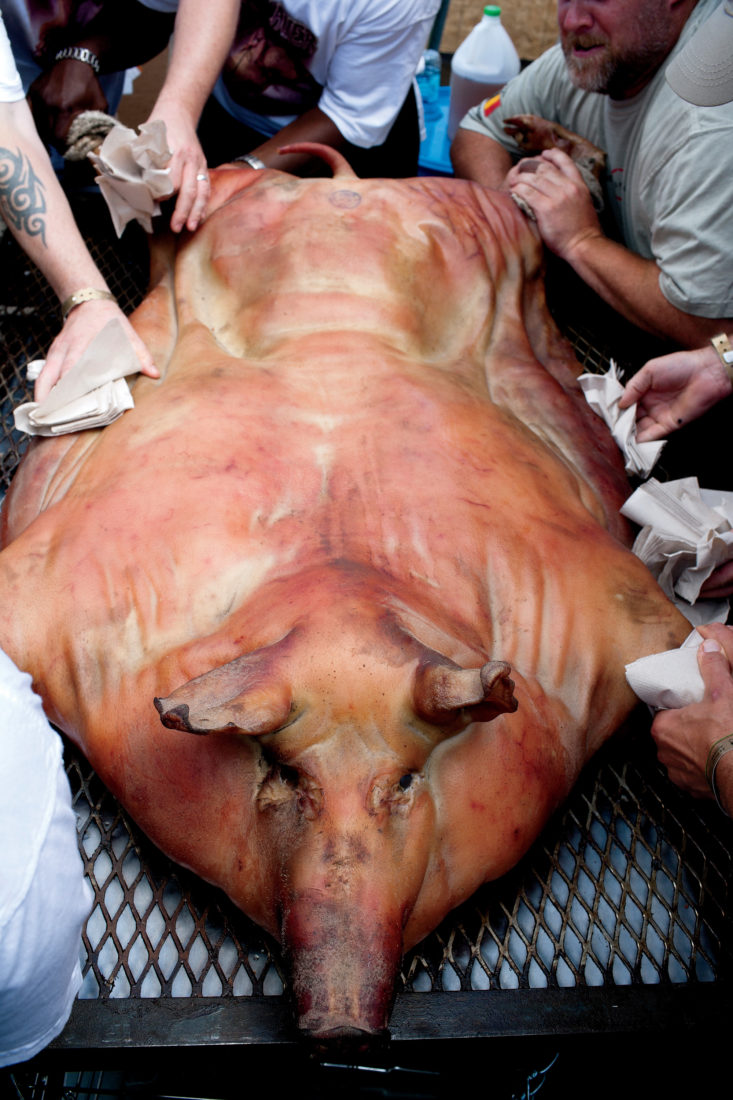
Photo: Michael Turek
Before a man with one leg got women to take their shirts off while he poured liquor into their mouths via an ice luge; before the wild-eyed guy who provides the pigs to the French Laundry walked around the party slipping packages in people’s hands, which at least two of us thought were drugs but turned out to be bacon; before Donald Link’s boudin for lunch and John Currence’s andouille for happy hour and Sean Brock’s soft-shell crab for dinner; before ten-year-old Jess Edge asked his daddy, the Southern food guru John T. Edge, “What’s a Jell-O shot?”; before we waited to hear if we’d made the finals of the Memphis in May World Championship Barbecue Cooking Contest; before the revolutionary act of creating an all-star team that included four James Beard Award–winning chefs, three old-school Southern pit masters, and one boozehound writer; before any of that, there was a pretentious but earnest idea: Could we rescue a barbecue contest, and maybe even barbecue itself, from a crushing sameness?

Photo: Michael Turek
The line was drawn. On one side, us: a cooking team called the Fatback Collective, organized by barbecue industrialist Nick Pihakis, who founded the Jim ’N Nick’s Bar-B-Q chain of restaurants. On the other, Memphis and its world-famous barbecue contest, entering its thirty-fourth year and drawing an estimated 100,000 fans. Now, Memphis in May is many things: a place for Parrotheads to gather between nautical-pun tours, a grown-up frat party with a hundred thousand pledges, a place where friends commune over a smoking pig, and, maybe most important, a driver of where our barbecue culture will go. Here’s what it isn’t: a reflection of where our barbecue has been. We wanted to turn back the clock.
Maybe that’s silly. Maybe that’s an idea
fueled by ten cases of whiskey and two thousand Jell-O shots, but from the belly of the beast, surrounded by what many of us consider to be a threat to authentic barbecue —lean pigs, tricked out with injections, cooked not as a reflection of a family or place, not as a connection to our past, but, rather, gamed to the strange tastes of the Memphis judges—we all realized the mission of the Fatback Collective: redemption.
Redemption and about seventeen thousand calories a day, most of them liquid.
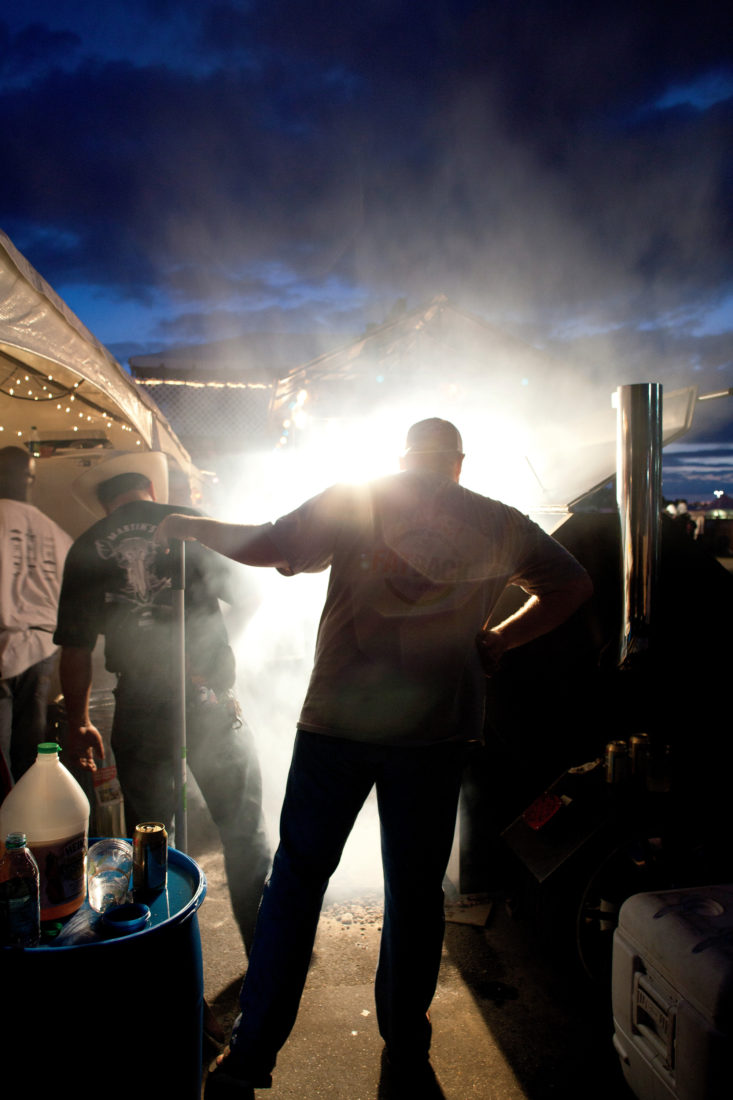
Photo: Michael Turek
Holy Smoke
Pat Martin mans the pit.
Ready, Set, Strip
It all starts with a screaming buzz saw and the smell of burning pig bone.
A hog is splayed out and gutted, with a half dozen hands reaching inside its carcass. Pat Martin, a Nashville pit master, revs the blade and digs into the backbone. Pig shrapnel flies around the tent.
When the job is done, the truly heartbreaking part begins, trimming out pounds of glorious, expensive, and carefully cultivated fat. Our team is consulting with a former grand champion, someone who is gracefully helping us understand the intractable customs of Memphis in May. He points at the thick layers of white.
The chefs look at each other, then at the pig. Reluctantly, they start stripping. Every so often, they’ll make eye contact with one another and shake their heads. Someone mutters. Brock stands to the left of the pig, and Link on the right, each cutting back ribs to expose more shoulder meat. A pile of fat forms on the table.
“Too much,” says Ryan Prewitt, the chef de cuisine at Herbsaint in New Orleans.
Stephen Stryjewski, the chef at Cochon who won his Beard award just four days ago, asks the expert once more if he’s sure.
“They don’t want marbling?” he asks.
“You don’t find that in other hogs,” the former grand champion says. “Technically, they don’t want to see that.”
“That’s so 180 degrees to what I do every day,” Stryjewski says.
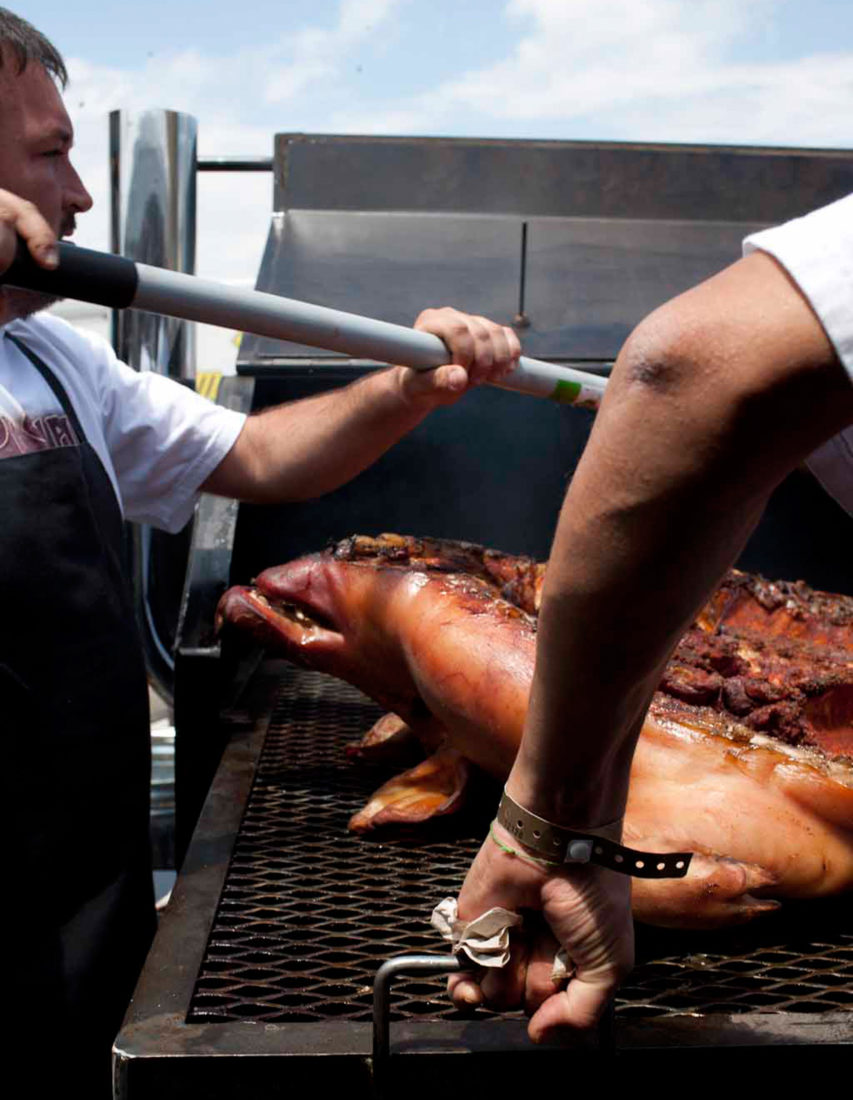
Link, the mind behind Cochon and Herbsaint, watches in silence. This is what he’s thinking: Arrrgh! There are all these Beard winners with their hands in the hog, but something is being lost in translation. A chef’s job is to cook food that stays true to the essence of the ingredients. The job of a Memphis in May contestant is to deliver what the judges want, and, more important, to stay away from things they don’t. Here, as best as I can tell, are some of the things the judges don’t like:
1. Fat
2. Spice
3. Pork that tastes like pork, as opposed to pork that taste like it got pistol-whipped by MSG and sugar
4. Puppies
Gaming the System
The more I learn, the more I realize that winning this thing has less to do with great barbecue and more to do with anticipating the judges. They like sweet. They don’t like spice. They like tenderloin. They don’t like belly. On and on. So competitors study past winners, then go Mr. Wizard on the pigs. They fill the cavity with bricks of cold butter. They pack iced pillowcases around their tenderloins to stop the cooking. Some pigs are souped up with culinary nitrous oxide: liquid fat–laden injections.
This isn’t happening in a vacuum. For many, these traveling cooking teams are the face of Southern barbecue. Not the guys, like the pit masters on our team, who cook pigs in the same pit three hundred days a year. The most wonderful thing about barbecue has always been its regional differences. Each pig told a story. Rodney Scott, pit master at Scott’s Bar-B-Que in Hemingway, South Carolina, uses wood he chops himself. Pat Martin was born in Mississippi but worked as a bond trader in Charlotte before realizing his calling, and his Beach Road 12 sauce, with the Carolina tang and a touch of the Memphis sweet, is a reflection of his own journey to the pit. Barbecue changes from town to town, an entire style morphing at the Tennessee River, or at the Piedmont, or when you sweep down onto Highway 61 from Memphis to Clarksdale, Mississippi. Memphis in May, the most important barbecue event in the world, rewards homogeneity. If you live in the South, maybe you’ve noticed how hard it’s becoming to find a good, simple barbecue sandwich. Traditional barbecue is fading as competition barbecue is rewarding smoke and mirrors.
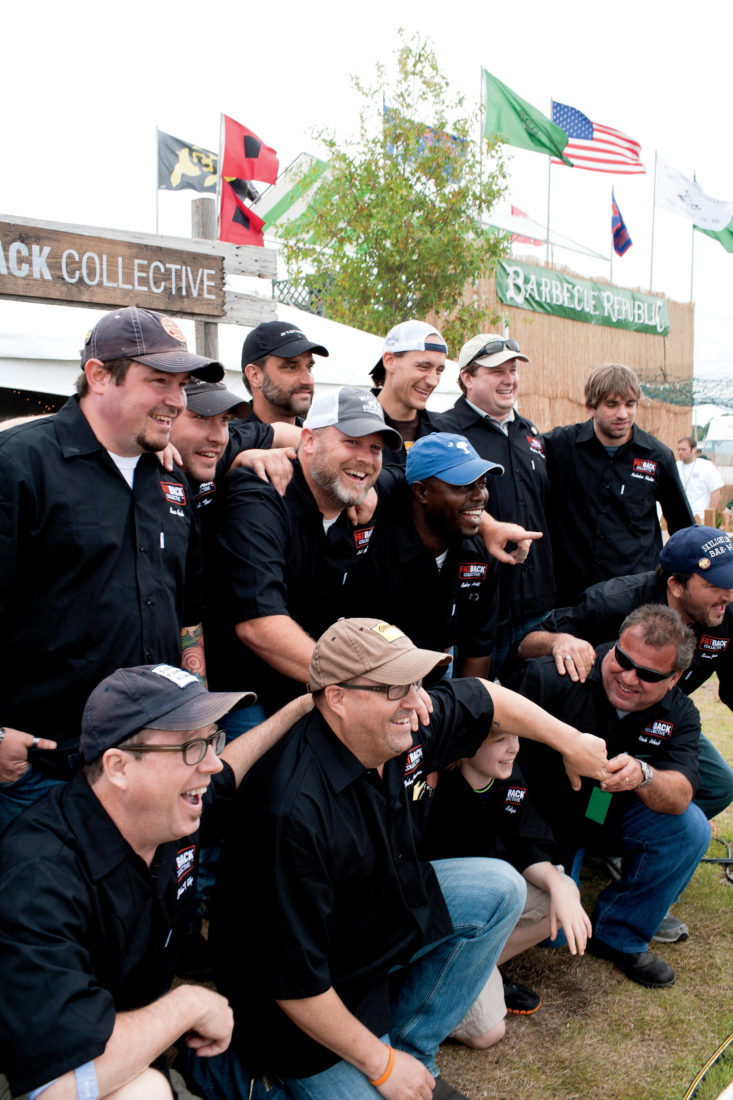
Photo: Michael Turek
Dream Team
The Fatback Collective gathers for a group photo.
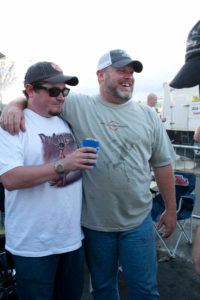 So while we do cut away some of the fat, more than the chefs would have liked, there is still plenty left on the hog. I’ve never seen a pig like this. It’s marbled, laced with thin lines of fat. It looks like a rib eye steak. There are fewer than a thousand Mangalitsas in North America, and this is the first time, to the best of everyone’s knowledge, that one has ever been barbecued. (We’re putting two on the coals.) It could put a new face on barbecue or, more accurately, give barbecue its old face back. The guys shake on a rub, the extent of the doctoring, and look down at the pit-ready pig.
So while we do cut away some of the fat, more than the chefs would have liked, there is still plenty left on the hog. I’ve never seen a pig like this. It’s marbled, laced with thin lines of fat. It looks like a rib eye steak. There are fewer than a thousand Mangalitsas in North America, and this is the first time, to the best of everyone’s knowledge, that one has ever been barbecued. (We’re putting two on the coals.) It could put a new face on barbecue or, more accurately, give barbecue its old face back. The guys shake on a rub, the extent of the doctoring, and look down at the pit-ready pig.
“I think we should do a shot of bourbon,” says Drew Robinson from Jim ’N Nick’s.
There are murmurs of agreement. Hell, yeah. Breakfast.
“I’ll get the Pappy Van Winkle,” says Brock, chef/owner of Husk in Charleston, South Carolina.
Pappy is poured into those flimsy cone-shaped water cups. I hold mine over the pig and knock it back.
“Bourbon and pigs,” Link says.
The Wee Hours
Bourbon and pigs. That fairly sums up my next twenty hours. The pit doors shut and smoke rolls out. Nothing to do but wait. The chefs and pit masters hold little summits, conversations that food nerds would freak out over. There is laughter. There is boudin and soft-shell crabs and oysters and crawfish. There are trays of Jell-O shots, and big cups of bourbon, and people dance until the speakers overheat. There is some drama at the pig; the fire gets too hot, but Rodney Scott finesses the coals, brings the temperature down. There’s no pit problem he can’t fix. You’ve seen Pulp Fiction? He’s the Mr. Wolfe of pork.
I fall asleep in a chair by the pit and later move to a couch. I wake up at 4:30 a.m. to find Scott and Brock still awake. Brock and I tag out, and I settle in next to Scott. He’s bulletproof. I’m not. The Pappy is gone. There’s a dead tall boy of Pabst and a cashed bottle of Patrón on a table, along with the empty shell casings of Jell-O shots.
“We look rough,” says Sarah Johnson from Jim ’N Nick’s.
“I feel rough,” Brock says.
Scott puts R&B on the speakers. Al Green brings us back to life. We’ve been goofballs for the past two days, but when the end comes, it’s all business.
“Do you feel good about this?” Nick
Pihakis asks.
Brock nods.
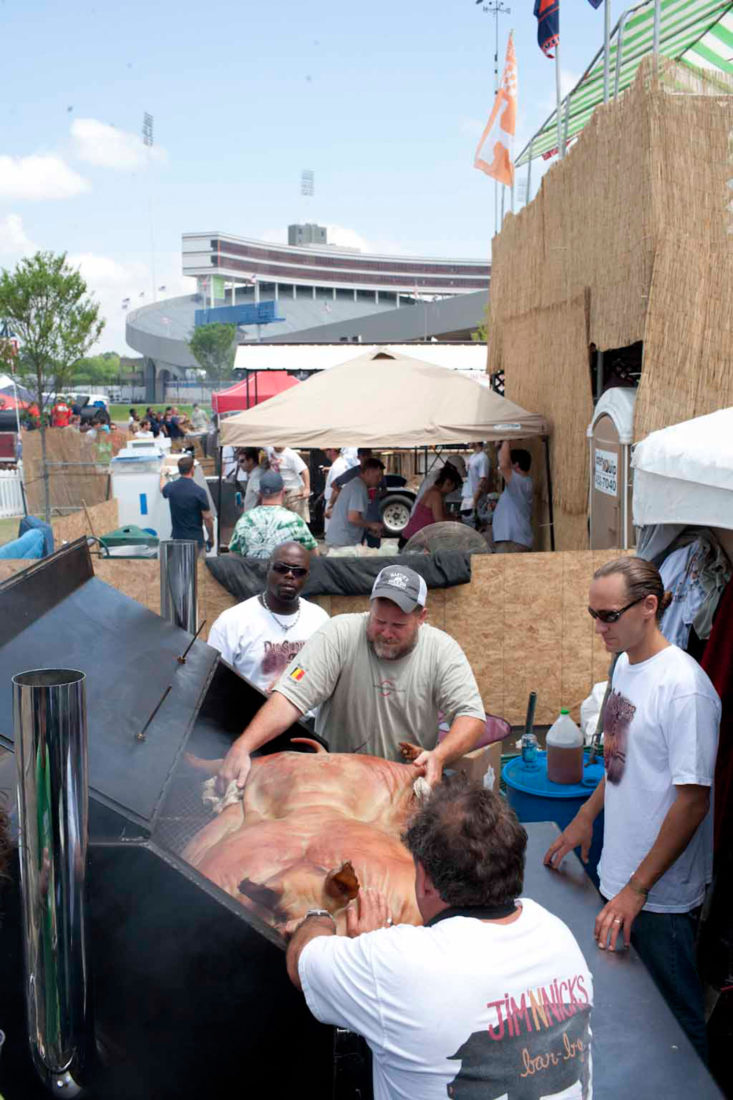
It’s time to create the Box. We’ve talked about the Box endlessly, lending it the importance of an advanced policy initiative, which seems slightly ridiculous, given that the Box is a Styrofoam container of cooked pig. But the Box is for the most important part of judging, the blind taste test, so there are four Beard-winning chefs on the Jim ’N Nick’s mobile smoking rig. Everyone is calm, quiet, with a few jokes and short, precise comments. The Box has to go at noon. Link has a knife in his hand. Some of the Beach Road 12 sauce is in a jug; abstract ideas and theories are great, but these guys didn’t become who they are by trying to lose. Some of my snark evaporates as I realize every team is doing this exact same thing.
“It’s 11:50, guys,” John Currence, from City Grocery in Oxford, Mississippi, says quietly.
What follows is a damn impressive ten minutes. My boys are stone cold. Nobody ever raises his voice or appears to rush, and I realize that before these guys were famous, they spent their lives in hot kitchens, cranking out dinner night after night. All thirty-four other whole hog teams are equally concerned with sticking the landing.
The Box is off, and three in-person judges are coming through. They are given the Gospel According to Fatback. Pat Martin does most of the talking. They hear about the Mangalitsas, about the pit masters and the chefs, about Martin’s dream of a win at Memphis in May changing the arc of the pig industry, replacing the flavorless factory hogs with ones more like our grandparents ate. His son, he testifies, might one day enjoy the results of our work today. Finally, the last judge leaves, and Scott walks back to the pit. Sam Jones, whose joint, the Skylight Inn in Ayden, North Carolina, grew out of a family barbecue tradition that dates back two hundred years, is standing there.
“We are so full of it,” Scott says.
“Full of what?” Jones asks.
“Truth,” Scott says.
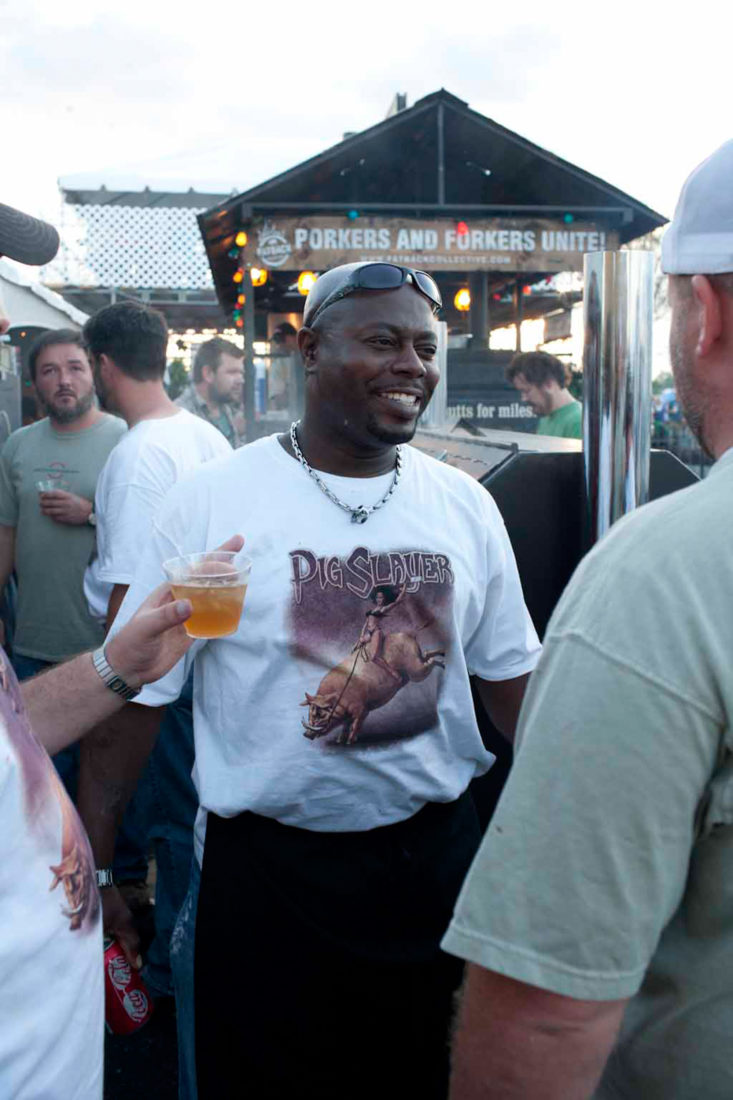
Fatback Glory
Pihakis is worthy of love for many reasons, for his generosity, for his terrible dancing, and for his creation of the Fatback Collective. But the moment I really want to spoon him is when he arranges for $500 worth of Gus’s World Famous fried chicken to be delivered to the tent just after the judges leave. People make love to that chicken, coming up for air with faces and fingers covered in grease—“That’s my last meal,” Brock gushes, orbiting the tables like some sort of bird of prey—and I eat, very quickly, four chicken thighs and two pieces of Wonder bread. So, we’re pigging out, and someone is telling Drew Robinson that bad news comes via a messenger on foot, but if you make it to the finals, a judge will arrive in a golf cart. At that exact moment, a golf cart pulls up.
“You mean like that?” Brock asks.
The Fatback Collective is in the final three.
The last group of judges arrive, four this time, and the show is smooth. They eat the pig and head out to make their decision. The confidence is palpable. People are flocking to the pit to pull out meat. Word has spread that the team of ringers has the greatest barbecue ever cooked. There are judges coming by just to eat. One tells me: “You’ve got it in the bag.” A feeling arises.
“If we win this thing,” Pihakis says, “people are gonna look at pork differently.”
We go stand by the stage. Someone there has a pig’s head on a stake, with a cigarette in its mouth, a picture of excess that defines much of Memphis in May.
“This is the old model,” Edge says.
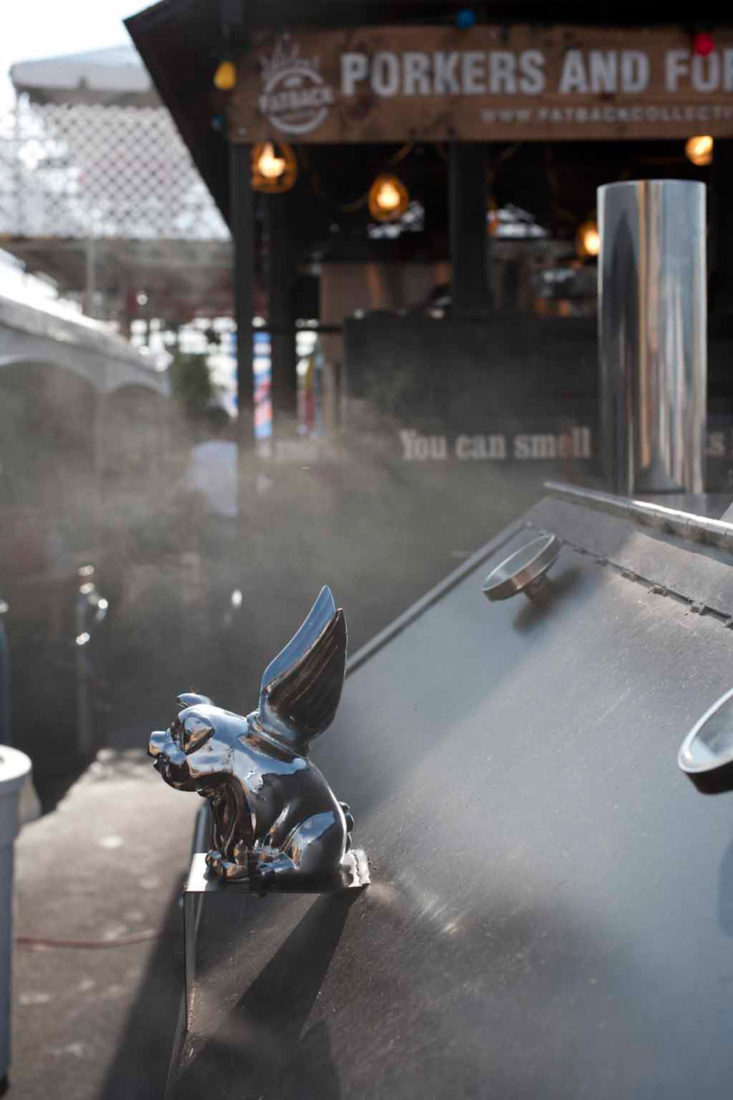
However, we are not entirely innocent. We consulted a past champion. We did a taste test on various sauces. We tried to game the judges, too, while preserving our integrity. We came here wanting to change this competition, but now, in the last moments, we want to win it. I haven’t even cooked anything—my role is to be a hyper-partisan observer—and even I want to win. I’ve rolled my eyes for the past two days at the other teams, and now I realize my ire is misplaced. Everybody else isn’t trying to educate the judges—they are trying to kick ass. And, as a look at the tense Fatback Collective confirms, so are we. Finally, the results are announced. The winner is Yazoo’s Delta Q, the same team that won last year.
Fatback Collective is third.
We shuffle to the stage, trying to smile. The crowd cheers, and all our hopes of stopping the homogeneous ’cue train suddenly feel like sour grapes. We are lots of things, but we are not sore losers. Martin takes the microphone and tells the other cooks that we all respect the hell out of what they do. Those are his exact words, and after, teammates slip up to him to tell him he nailed it. We go back to the tent, and there is talk of how great it is to finish third in our first year, and hugs, and drinks, but the DJ cuts to the heart of the feelings in the tent. We are serenaded with “Auld Lang Syne.”
Truth in Barbecue
After Sean Brock grew up “dirt, dirt, dirt poor,” with a dream that seemed impossible from the forgotten corner of Virginia he called home; after he won his Beard medal at age thirty-two and hid with his cell phone in a Lincoln Center bathroom, weeping, calling to tell his mama, I did it; after Donald Link did for boudin what Arnold Palmer did for golf; after Sam Jones tended his pit the same way his ancestors did two hundred years ago; after Rodney Scott showed up to man the fires at midnight the night he graduated from high school; after John Currence learned to cook on a tugboat the morning after he graduated; after we traveled to Memphis to try to change the way people think about barbecue; after we succeeded, and also failed; after all that, I can’t shake an image that I’ll cherish long after my cardiologist buys a new ski boat with the money he’ll make off the weekend: Pat Martin, our loud, opinionated mouth of the South, sitting in the corner, waiting to find out if we’d won.
He’s quiet now, with his little boy on his lap. They have the same haircut. Martin gives his son a kiss and rubs his forehead. He holds him tight. Something becomes clear in this moment. The real barbecue we love, that we pretentiously and earnestly came to save, might be under siege, but it isn’t dead. It lives in anyone who believes in doing things the way their grandfathers did, who believes that what we eat tells a story about who we are. It lives in anyone who cares enough to sit all night with a hog. It lives in the fading notes of “Auld Lang Syne” and in the sparks popping off the burn barrel past midnight. It lives in the way a father holds his boy when the cooking is done.
Photo: Michael Turek
1 of 39
Photo: Michael Turek
2 of 39
Photo: Michael Turek
3 of 39
Photo: Michael Turek
4 of 39
Photo: Michael Turek
5 of 39
Photo: Michael Turek
6 of 39
Photo: Michael Turek
7 of 39
Photo: Michael Turek
8 of 39
Photo: Michael Turek
9 of 39
Photo: Michael Turek
10 of 39
Photo: Michael Turek
11 of 39
Photo: Michael Turek
12 of 39
Photo: Michael Turek
13 of 39
Photo: Michael Turek
14 of 39
Photo: Michael Turek
15 of 39
Photo: Michael Turek
16 of 39
Photo: Michael Turek
17 of 39
Photo: Michael Turek
18 of 39
Photo: Michael Turek
19 of 39
Photo: Michael Turek
20 of 39
Photo: Michael Turek
21 of 39
Photo: Michael Turek
22 of 39
Photo: Michael Turek
23 of 39
Photo: Michael Turek
24 of 39
Photo: Michael Turek
25 of 39
Photo: Michael Turek
26 of 39
Photo: Michael Turek
27 of 39
Photo: Michael Turek
28 of 39
Photo: Michael Turek
29 of 39
Photo: Michael Turek
30 of 39
Photo: Michael Turek
31 of 39
Photo: Michael Turek
32 of 39
Photo: Michael Turek
33 of 39
Photo: Michael Turek
34 of 39
Photo: Michael Turek
35 of 39
Photo: Michael Turek
36 of 39
Photo: Michael Turek
37 of 39
Photo: Michael Turek
38 of 39
Photo: Michael Turek
39 of 39









































